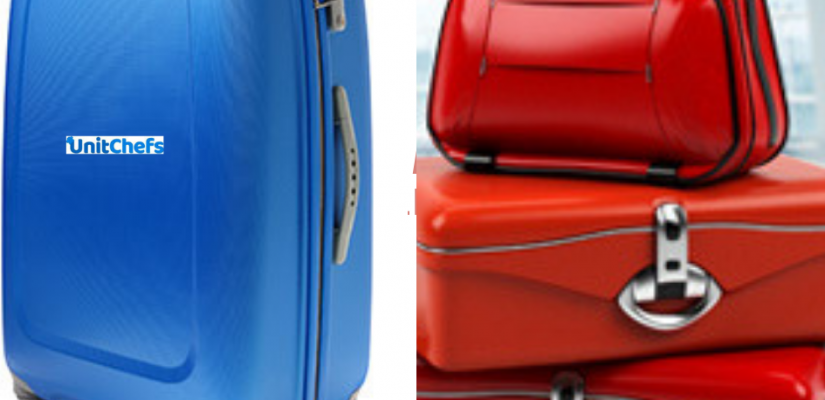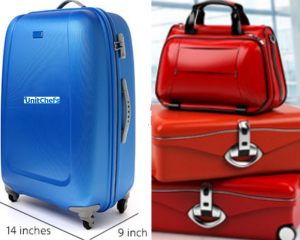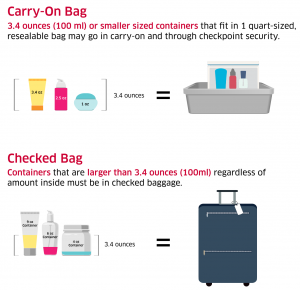
Airline Luggage Size and Weight Requirements
Airlines have all sorts of different requirements, but the most important ones concerning the passengers are the requirements and restrictions related to luggage, luggage size, weight, and contents. Those are applied either for security reasons, safety and comfort.
The different airlines have different luggage size, weight and number of pieces conditions and restrictions but they are all in a similar range. The International Air Transportation Association (IATA) endeavors to unify and standardize luggage requirements, but there is yet no universal standard.

Why are liquids not allowed on flights? The short answer is for security reasons to prevent people (specifically terrorists) from hiding liquid explosives disguised as beverages or other common objects in carry-on luggage. Passengers are allowed to pack one-quart-sized bag (with zip top) of liquids, aerosols, gels, creams, and pastes in their carry-on bag and through the security checkpoint. They should be in limited to travel-sized containers that are 3.4 ounces (100 milliliters) or less per item. Placing these items in the small bag and separating them from the carry-on baggage facilitates the screening process. If passengers would like to bring items that are in containers larger than 3.4 ounces or 100 milliliters, they should place them in checked baggage.
The regulation regarding the liquids in carry-on luggage was introduced in 2006 after the British Police uncovered a terrorist plot to detonate liquid explosives carried on board. This occurrence was generally known as the ‘2006 transatlantic aircraft plot’. The British policed managed to prevent the plot from fulfilling, but it all led to the implementation of tight security measures at airports everywhere around the world.
Liquids include:
- drinks, including water
- liquid or semi-liquid foods, for example, soup, jam, honey, and syrups
- cosmetics and toiletries, including creams, lotions, oils, perfumes, mascara and lip gloss
- sprays, including shaving foam, hairspray and spray deodorants
- pastes, including toothpaste
- gels, including hair and shower gel
- contact lens solution
- any other solutions and items of similar consistency
Requirements:
- The capacity of containers must be no more than 100ml
- They must be in a single, transparent plastic bag, which measures approximately 20cm x 20cm
- Contents must fit comfortably inside the bag so it can be sealed with ease
- There is a limit of 1 plastic bag per person
- The container must be shown at the airport security point
Exemptions for this restriction are:
- Medications,
- special dietary substances,
- baby food or baby milk.
Also, effective June 30, 2018, for international flights to the U.S., powder-like substances over 12 oz. / 350 mL should be placed in checked bags. Powders over 12 oz. / 350 mL in carry-on bags may be confiscated.
Carry-on luggage is used for convenience. It is available at all times and passengers can access their belongings in-flight, and there’s no waiting by the baggage claim after landing.
On the other hand, checking luggage means that passengers can hand it over and not worry about bringing large pieces of luggage through security and the rest of the airport.
You should check with your airline first, but most domestic airlines permit a carry-on piece of luggage that is 45 linear (total) inches. A common sized bag for carry-on luggage is 22″x 14″x 9″. Most airlines have a carry-on weight limit of 40 pounds.

Some airlines allow one piece of carry-on luggage and one small personal item on board. Personal items include handbags, briefcases, laptops, daypacks and small backpacks.
In addition to one carry-on and one personal item, passengers might bring on board a coat, reading the material, small bag of food and devices such as wheelchairs and walkers.
Most airlines permit a carry-on piece of luggage that is 45 linear (total) inches and a weight limit of 40 pounds. A common sized bag for carry-on luggage is 22″x 14″x 9″.
Still, all those specifics should be checked with the particular airline first, since the requirements vary.
Here is a list with airlines and the specific size and weight luggage requirements they enforce:
| Airline | Inches | Centimeters | Weight |
| Aer Lingus (EI) | 21.5 x 15.5 x 9.5 | 55 x 40 x 24 | 22 lb 10 kg |
| Aeromexico (AM) | 45 (linear) | 115 (linear) | 22 lb 10 kg |
| Air Canada (AC) | 21.5 x 15.5 x 9.5 | 55 x 40 x 23 | 22 lb 10 kg |
| Air France (AF) | 21.5 x 13.75 x 9.75 | 55 x 35 x 25 | 26.5 lb 12 kg |
| Air New Zealand (NZ) | 46.5 (linear) | 118 (linear) | 15 lb 7 kg |
| Alaska Air (AS) | 24 x 17 x 10 | 61 x 43 x 25 | |
| Alitalia (AZ) | 21.5 x 13.75 x 10 | 55 x 35 x 25 | 17 lb 8 kg |
| All Nippon Airways (NH) | 22 x 16 x 10 | 55 x 40 x 25 | 22 lb 10 kg |
| American Airlines (AA) | 22 x 14 x 9 | 56 x 36 x 23 | |
| Cathay Pacific (CX) | 22 x 14 x 9 | 56 x 36 x 23 | 33 lb 15 kg |
| Delta (DL) | 22 x 14 x 9 | 56 x 36 x 23 | |
| El Al (LY) | 22 x 18 x 10 | 56 x 45 x 25 | 17 lb 8 kg |
| Frontier (F9) | 24 x 16 x 10 | 60 x 40 x 25 | 35 lb 15.75 kg |
| Hawaiian (HA) | 22 x 14 x 9 | 56 x 36 x 23 | 25 lb 11.25 kg |
| Japan Airlines (JL) | 22 x 16 x 10 | 55 x 40 x 25 | 22 lb 10 kg |
| Jetblue (B6) | 24 x 16 x 10 | 55 x 40 x 25 | |
| KLM (KL) | 21.5 x 13.5 x 10 | 55 x 35 x 25 | 26 lb 12 kg |
| Korean Air (KE) | 21.5 x 16 x 7.75 | 55 x 40 x 20 | 26 lb 17 kg |
| Lufthansa (LH) | 21.5 x 16 x 9 | 55 x 40 x 23 | 17 lb 8 kg |
| Philippine Airlines (PR) | 45 (linear) | 115 (linear) | 15 lb 7 kg |
| Qantas Airways (QF) | 41 (linear) | 105 (linear) | 15 lb 7 kg |
| Saudi Arabian Airlines (SV) | 45 (linear) | 115 (linear) | 15 lb 7 kg |
| Scandinavian Airlines (SK) | 22 x 16 x 9 | 55 x 40 x 23 | 17 lb 8 kg |
| Singapore Airlines (SQ) | 45 (linear) | 115 (linear) | 15 lb 7 kg |
| Southwest Airlines (WN) | 22 x 16 x 10 | 55 x 40 x 25 | |
| Spirit (NK) | 22 x 18 x 10 | 55 x 45 x 25 | |
| Sun Country Airlines (SY) | 24 x 16 x 11 | 61 x 40 x 28 | 35 lb 15.75 kg |
| United (UA) | 22 x 14 x 9 | 56 x 36 x 23 | |
| US Airways (US) | 22 x 14 x 9 | 56 x 36 x 23 | |
| Virgin (VX) | 50 (linear) | 127 (linear) | 30 lb 14 kg |